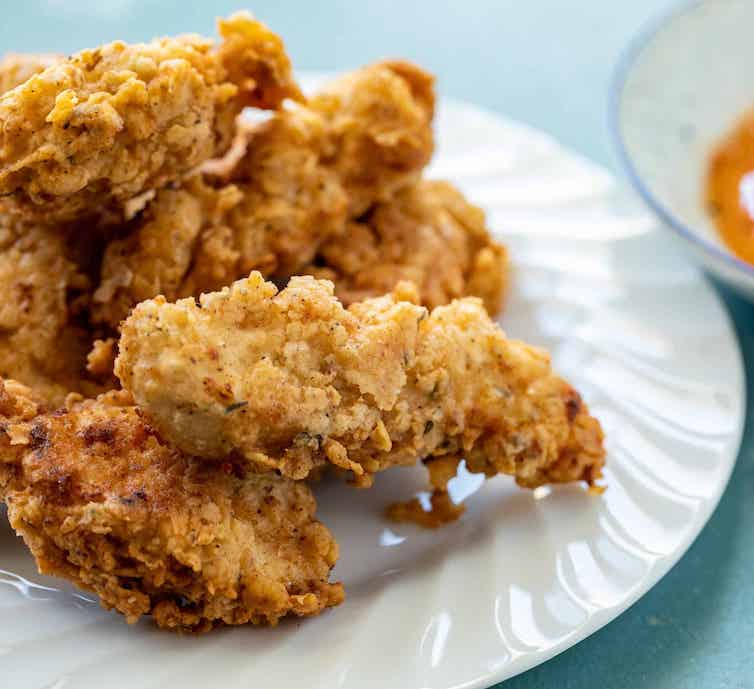Print
Shatter-Batter Chicken Tenders with Honey Mustard Dipping Sauce
Chef Nyesha Arrington's take on a fried food classic, super-cripsy fried chicken tenders marinated in buttermilk with a honey-mustard dipping sauce.
Servings 4
Ingredients
For the Brine:
- 10 Chicken tenders
- Canola oil
- 3 cups buttermilk
- 5 thyme sprigs
- 2 tablespoons salt
- 2 teaspoons sugar
For the Batter:
- 3 cups soda water + more if necessary
- 2 cups all purpose flour
- 1 cup rice flour
- 1 cup cornstarch
- 1 tablespoon baking powder
- ½ tablespoon baking soda
- 1 teaspoon kosher salt
- 1 teaspoon onion powder
- 1 teaspoon garlic powder
- ½ teaspoon cayenne pepper
- ½ teaspoon paprika
- ½ teaspoon mustard powder
- ½ teaspoon black pepper
- 4 organic large egg whites
For the Honey Mustard
- ½ cup mayonnaise
- 2 tablespoons prepared yellow mustard
- 1 tablespoon Dijon mustard
- 2 tablespoons honey
- ½ tablespoon lemon juice
Instructions
DAY BEFORE:
- In a large mixing bowl, add buttermilk, salt, sugar and marinate chicken tenders in buttermilk brine (for at least 25 minutes, preferably 24 hours).
- Mix the mayonnaise, yellow mustard, Dijon mustard, honey, and lemon juice together in a bowl. Cover and chill in refrigerator overnight.
DAY OF:
- In a large mixing bowl, sift AP flour, rice flour and cornstarch. Mix briefly.
- Add baking powder, baking soda, salt, onion powder, garlic powder, cayenne, paprika, mustard powder and black pepper. Whisk together.
- Add soda water and mix briefly.
- In a separate medium mixing bowl, add egg whites and whisk until light and airy.
- Fold egg whites into a larger mixing bowl with batter. Do not over mix.
- In a separate medium mixing bowl, add about 2.5 cups AP flour.
- In a deep skillet, add canola oil. Heat to 350f degrees.
- Once oil is heated, add 1 TSP (or small spoonful) of oil blend to batter and mix gently.
- Dust chicken tenders in flour, then dip into batter.
- Fry for 4-5 minutes or until chicken is thoroughly cooked.
- Rest for 3-4 minutes.
- Take rested chicken tenders and fry for 1-2 additional minutes at 425 degrees.
- Season w fine salt.
Video
Print
Whipped Potatoes
If you order mashed potatoes at a fine-dining restaurant, how are they different than the ones you make at home? They taste like THIS.
Ingredients
- 3 pounds Russet or Yukon potatoes peeled and quartered into evenly sized pieces
- ¾ pound Vermont aged white Cheddar grated
- ½ teaspoon baking powder
- 1 teaspoon kosher salt
- Black pepper to taste
- Small pinch cayenne
- 6 tablespoons unsalted butter melted
- ¾ cup heavy cream heated
- 2 eggs lightly beaten
Instructions
- Add potatoes to a large pot of well-salted water, bring to a boil and then immediately reduce heat to a simmer and cook until very tender, about 10-12 minutes.
- Drain well in a colander, return to pot and gently shake the burner to help cook off any remaining water. Rice.
- Place riced potatoes into the bowl of a stand mixer fitted with a whisk attachment along with the cheese, baking powder, salt, pepper, and cayenne. Mix for 1 minute on medium speed.
- Reduce speed and add butter and cream, then increase speed to medium and drizzle in beaten eggs. Stop and scrape down bowl with rubber spatula to make sure ingredients are incorporated evenly. Beat at medium-high speed ONLY until mixture is smooth. DO NOT OVERMIX.
- Serve immediately in a heated bowl. Alternatively, transfer potatoes to an oven-safe dish, cover with foil and let stand at room temperature. Reheat for 30 to 40 minutes at 350 degrees, until piping hot. (If you want the top browned, remove foil halfway through baking. Otherwise give the potatoes a stir before serving.)
- Mashed potatoes reheat very well the following day and most people find that the cheese flavor is more pronounced after sitting overnight in the refrigerator. Heat on 350*F, stirring frequently, making sure the edges of the mashed potatoes don't burn.
Notes
During the Seven Years War of the mid-1700s, a French army pharmacist named Antoine-Augustin Parmentier was captured by Prussian soldiers. As a prisoner of war, he was forced to live on rations of potatoes. In mid-18th century France, this would practically qualify as cruel and unusual punishment: potatoes were thought of as feed for livestock, and they were believed to cause leprosy in humans. The fear was so widespread that the French passed a law against them in 1748.
But as Parmentier discovered in prison, potatoes weren’t deadly. In fact, they were pretty tasty. Following his release at the end of the war, the pharmacist began to proselytize to his countrymen about the wonders of the tuber. One way he did this was by demonstrating all the delicious ways it could be served, including mashed. By 1772, France had lifted its potato ban. Centuries later, you can order mashed potatoes in dozens of countries, in restaurants ranging from fast food to fine dining.


